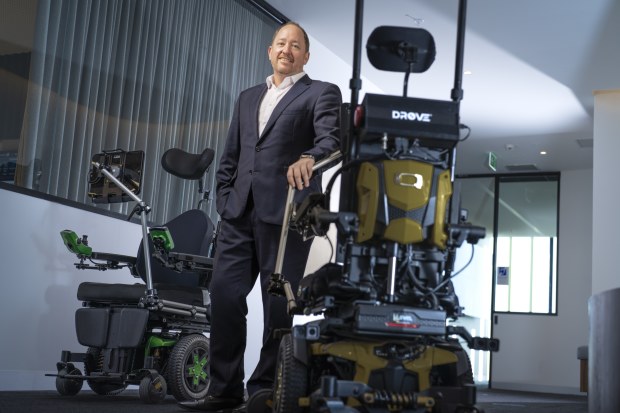Control Bionics teams with Deakin Uni for mind-controlled wheelchair

Deakin University has teamed up with the listed med-tech start-up Control Bionics to produce what they say is the world’s first upgrade for powered wheelchairs, so they can be controlled by the user’s thoughts.
The module, known as Drove, automatically steers powered wheelchairs along pre-defined routes through a house, giving new freedom to users to who might ordinarily have to rely on carers to move them from room to room.

Jeremy Steele, CEO of Control Bionics, with the Drove wheelchair upgrade Eamon Gallagher
A wheelchair user who has control of only their eye movement, for example, will be able to look at the word “Kitchen” on a tablet attached to the wheelchair, and then click on that word using their thoughts, setting the wheelchair off towards a predefined spot in the kitchen, said Control Bionics chief executive Jeremy Steele.
The routes and destinations in a house would first have to be set up by technicians, who would install dozens of small, QR-code-like stickers known as “fiducial” markers on the ceiling, that can be tracked by a camera on top of the Drove module to ensure the wheelchair stays on course.
Future versions of Drove, which works as a retrofit device on existing wheelchairs, might use machine learning to plot new routes in real time around the home, but fiducial stickers were a lower-cost and more reliable technology for now, Mr Steele said.
Sensors at the bottom of the module will stop the wheelchair whenever an obstacle is detected, he said, but wheelchair users would need to get themselves onto a pre-defined route, or have someone push their chair onto the route, before the Drove could take over the driving.
The retrofit can work with any number of existing wheelchair control systems, including Control Bionics’ own NeuroNode wearable controller, which allows users to make the equivalent of mouse clicks to control devices such as tablets, TVs and computers, either through making gestures with some part of their body, or through simply thinking about such gestures.
The NeuroNode device, which can be worn anywhere on the body the user has most control over, features both an accelerometer for detecting actual movements, as well as electromyography (EMG) sensors, which can detect the minute electrical impulses people send to their muscles when they simply think about moving, even if the muscles aren’t actually activated.
Mr Steele took over as the CEO of Control Bionics in January this year, replacing the company’s interim CEO and founder, Peter Ford, who stayed on as a director of innovation.
The Melbourne-based small-cap, which reported a loss of $2.59 million in the second half of 2022, had struggled to sell its technology during COVID, Mr Steele said, and so he’d been brought in to get the company back on track.
During COVID “we weren’t able to grow as quickly as we would like,” he said.
“We sell products to some of the highest-need individuals that exist and obviously the impact of COVID on those people was huge. If you can’t sit in front of the end-user and explain to them how the system works and how you get it up and running, then it’s quite a difficult sales process,” he told The Australian Financial Review.
“And you’ve seen that impact in the share price,” he said.
After listing in December 2020 at $1 a share, shares in Control Bionics have languished at around 17¢ in 2023, closing Tuesday at 14¢.
Pricing for the Drove module has yet to be set, Mr Steele said, but comparable technology sells for around $13,000.
Subscribe to gift this article
Gift 5 articles to anyone you choose each month when you subscribe.
Subscribe nowAlready a subscriber?
Introducing your Newsfeed
Follow the topics, people and companies that matter to you.
Find out moreRead More
Latest In Technology
Fetching latest articles